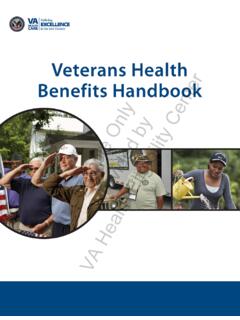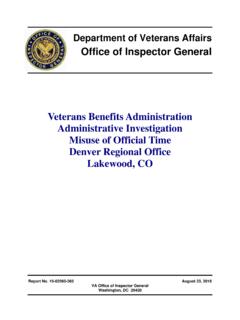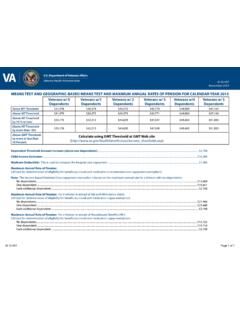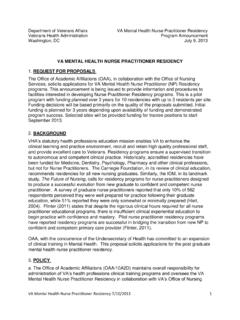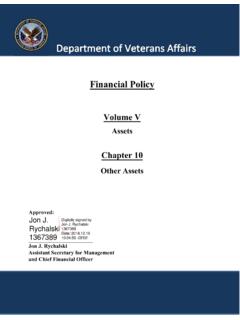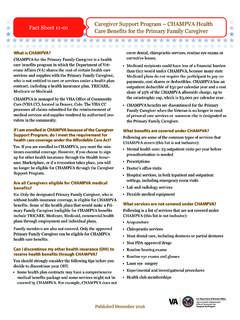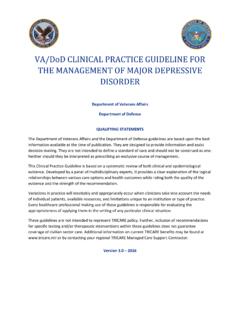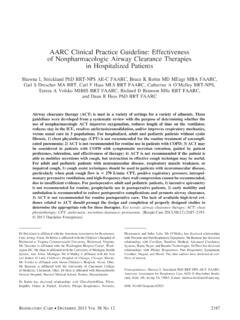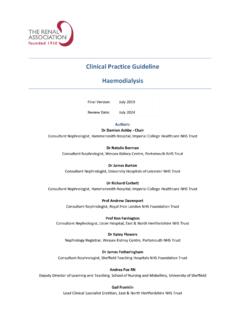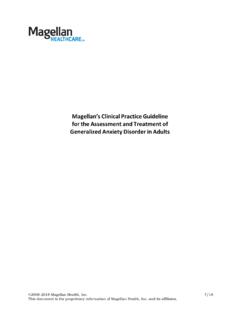Transcription of VA DoD Clinical Practice Guideline for Opioid Therapy for ...
1 VA/DoD Clinical Practice Guideline FOR Opioid Therapy FOR CHRONIC PAIN Department of Veterans Affairs Department of Defense QUALIFYING STATEMENTS The Department of Veterans Affairs and the Department of Defense guidelines are based upon the best information available at the time of publication. They are designed to provide information and assist decision making. They are not intended to define a standard of care and should not be construed as one. Neither should they be interpreted as prescribing an exclusive course of management. This Clinical Practice Guideline is based on a systematic review of both Clinical and epidemiological evidence. Developed by a panel of multidisciplinary experts, it provides a clear explanation of the logical relationships between various care options and health outcomes while rating both the quality of the evidence and the strength of the recommendation.
2 Variations in Practice will inevitably and appropriately occur when clinicians take into account the needs of individual patients, available resources, and limitations unique to an institution or type of Practice . Every healthcare professional making use of these guidelines is responsible for evaluating the appropriateness of applying them in the setting of any particular Clinical situation. These guidelines are not intended to represent TRICARE policy. Further, inclusion of recommendations for specific testing and/or therapeutic interventions within these guidelines does not guarantee coverage of civilian sector care. Additional information on current TRICARE benefits may be found at or by contacting your regional TRICARE Managed Care Support Contractor. Version 2017VA/DoD Clinical Practice Guideline f or Opioid Therapy f or Chronic Pain February 2017 Page 2 of 198 Prepared by: The Opioid Therapy for Chronic Pain Work Group With support from: The Office of Quality, Safety and Value, VA, Washington, DC & Office of Evidence Based Practice , Army Medical Command Version 201 7 Based on evidence reviewed through December 2016VA/DoD Clinical Practice Guideline f or Opioid Therapy f or Chronic Pain February 2017 Page 3 of 198 Table of Contents.
3 5 to Use This Clinical Practice Guideline .. 67 10 11 12 13 14 15 15 16 16 19 20 21 21 26 26 27 27 31 .. A: Determination of Appropriateness for Opioid Therapy .. B: Treatment with Opioid Therapy .. C: Tapering or Discontinuation of Opioid Therapy .. D: Patients Currently on Opioid Therapy .. Epidemic .. Shift in Pain and Its Treatment .. Safe Opioid Prescribing practices and Use .. and Impact .. Pain and Co-occurring Conditions .. Factors for Adverse Outcomes of Opioid Therapy .. this Clinical Practice Guideline .. of this Clinical Practice Guideline .. Features of this Clinical Practice Guideline .. of Patient Focus Group Methods and Findings .. 31 32 33 34 34 35 37 38 39 39 of Interest .. Care .. Decision Making .. Care Model for Pain Management .. of Care .. Decision Support Tools .. Work Group .. of Recommendations.
4 And Continuation of Opioids .. VA/DoD Clinical Practice Guideline f or Opioid Therapy f or Chronic Pain February 2017 Page 4 of 198 Mitigation .. 46 51 70 71 75 75 75 80 81 81 88 99 100 105 105 110 116 116 120 122 , Dose, Duration, Follow-up, and Taper of Opioids .. Therapy for Acute Pain .. Appendix A: VA Signature Informed Consent .. Appendix B: Urine Drug Testing .. of Urine Drug Testing .. of Urine Drug Testing .. Appendix C: Diagnostic and Statistical Manual of Mental Disorders for Opioid Use Disorders .. Appendix D: Drug Tables .. , Orally Administered Opioids .. -acting/Extended-release Opioids .. Milligram Equivalent Doses .. Dosing Guidance .. Appendix E: Evidence Review Methodology .. the Scope and Key Questions .. the systematic Review .. the Face-to-face Meeting .. Recommendations .. Categorization .. and Submitting the Final Clinical Practice Appendix F: Patient Focus Group Methods and Findings.
5 123 123 124 127 16132 3 165 165 173 182 185 .. Focus Group Findings .. Appendix G: Evidence Table .. Appendix H: 2010 Recommendation Categorization Table .. Appendix I: Participant List .. Appendix J: Literature Review Search Terms and Strategy .. Search Terms .. Strategies .. Appendix K: Abbreviation List .. References .. VA/DoD Clinical Practice Guideline f or Opioid Therapy f or Chronic Pain February 2017 Page 5 of 198 Department of Veterans Affairs (VA) and Department of Defense (DoD) Evidence-Based Practice Work Group (EBPWG) was established and first chartered in 2004, with a mission to advise the ..Health Executive Council on the use of Clinical and epidemiological evidence to improve the health of the population across the Veterans Health Administration and Military Health System, by facilitating the development of Clinical Practice guidelines (CPGs) for the VA and DoD populations.
6 [1] This CPG is intended to provide healthcare providers with a framework by which to evaluate, treat, and manage the individual needs and preferences of patients with chronic pain who are on or being considered for long-term Opioid Therapy (LOT). In 2010, the VA and DoD published the Clinical Practice Guideline for Management of Opioid Therapy for Chronic Pain (2010 OT CPG), which was based on evidence reviewed through March 2009. Since the release of that Guideline , there has been growing recognition of an epidemic of Opioid misuse and Opioid use disorder (OUD) in America, including among America s Veterans, as documented in the Background section. At the same time, there is a mounting body of research expanding detailing the lack of benefit and severe harms of LOT. Consequently, a recommendation to update the 2010 OT CPG was initiated in 2015. The updated CPG, titled Clinical Practice Guideline for Opioid Therapy for Chronic Pain (OT CPG), includes objective, evidence-based information on the management of chronic pain.
7 It is intended to assist healthcare providers in all aspects of patient care, including, but not limited to, diagnosis, treatment, and follow-up. The system-wid e goal of this Guideline is to improve the patient s health and well-being by providing evidence-based guidance to providers who are taking care of patients on or being considered for LOT. The expected outcome of successful implementation of this Guideline is to: Assess the patient s condition, provide education, and determine the best treatment methods incollaboration with the patient and a multidisciplinary care team Optimize the patient s health outcomes and function and improve quality of life Minimize preventable complications and morbidity Emphasize the use of patient-centered careVA/DoD Clinical Practice Guideline f or Opioid Therapy f or Chronic Pain February 2017 Page 6 of 198 to Use This Clinical Practice GuidelineThis Guideline can be used in a variety of ways.
8 It can be used by general clinicians or specialists to study and consider the latest information on Opioid Therapy (OT) and how and whether to incorporate that information or recommendations into their Practice . It can be used to provide specific information to guide a patient encounter, such as looking up the dosing of a medication used less frequently or the meaning of the urine drug testing (UDT ) result. The section on tapering and its accompanying appendix can be used to assist in the development of a framework for guiding an individualized, informed discussion when tapering is b eing considered. Patients can examine the Guideline to educate themselves and better understand their care. A health care system can use the CPG to assure that its clinicians and patients have the resources available to compassionately, effectively, and safely evaluate and deliver LOT in a timely, culturally sensitive manner.
9 The Guideline can also be used to suggest specific education for identified gaps. This Guideline is not intended as a standard of care and should not be used as such. Standards of care are determined on the basis of all Clinical data available for an individual case and are subject to change as scientific knowledge and technology advances and patterns evolve. Today there is variation among state regulations, and this Guideline does not cover the variety of ever-changing state regulations that may be pertinent. The ultimate judgement regarding a particular Clinical procedure or treatment course must be made by the individual clinician, in light of the patient s Clinical presentation, patient preferences, and the available diagnostic and treatment options. As noted previously, the Guideline can assist care providers, but the use of a CPG must always be considered as a recommendation, within the context of a provider s Clinical judgment and patient values and preferences, in the care for an individual patient.
10 VA/DoD Clinical Practice Guideline f or Opioid Therapy f or Chronic Pain February 2017 Page 7 of 198 III. Recommendations The following recommendations were made using a systematic approach considering four domains as per the Grading of Recommendations Assessment, Development and Evaluation (GRADE) approach as detailed in the section on Methods and Appendix E. These domains include: confidence in the quality of the evidence, balance of desirable and undesirable outcomes ( , benefits and harms), patient or provider values and preferences, and other implications, as appropriate ( , resource use, equity, acceptability). Given the relevance of all four domains in grading recommendations, the Work Group encountered multiple instances in which confidence in the quality of the evidence was low or very low, while there was marked imbalance of benefits and harms, as well as certain other important considerations arising from the domains of values and preferences and/or other implications.

